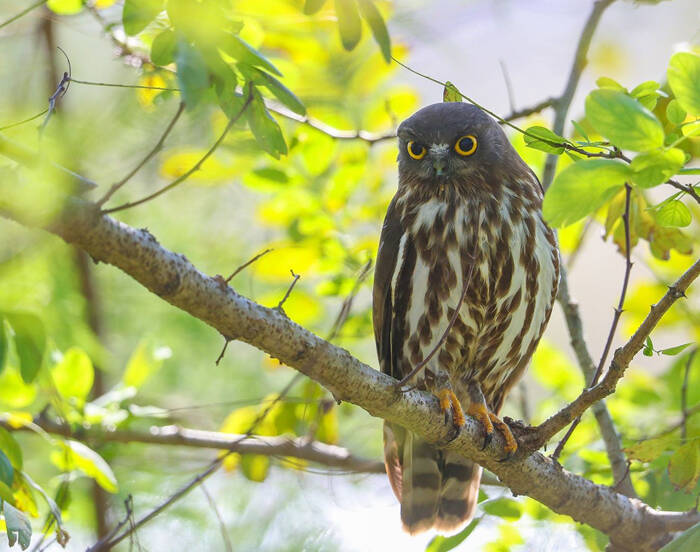Ninox japonica
IUCN
LCBasic Information
Scientific classification
- name:Ninox japonica
- Scientific Name:Ninox japonica,Northern Boobook,Northern Hawk Owl
- Outline:Raptor
- Family:Strigiformes Owl
Vital signs
- length:31-33cm
- Weight:168-250g
- lifetime:About 10-20 years
Feature
The eyes are large, dark, and eagle-like, hence the name.
Distribution and Habitat
Breeding range: China, Japan, North Korea, South Korea and Russia (East Asia).
Non-breeding range: Brunei, Indonesia and Malaysia.
Migrant bird: Philippines and Taiwan Province of China.
Origin uncertain: Palau.
Inhabits forests and woodlands below 1700 meters above sea level, occurs in mixed coniferous and broad-leaved forests and broad-leaved evergreen woodlands, especially prefers river valleys in forests, also occurs in woods, forest edge shrubs, plantations, orchards, mangroves and swamps in low mountains and hills and foothills plains. Wooded parks and gardens in farmland areas. Also occurs near human settlements, and may even breed in tall trees in wooded urban areas.
Appearance
The Japanese Eagle Owl has a body length of 31-33 cm, a wingspan of 66-70 cm, and a weight of 168-250 grams. It looks like an eagle, and this shape also helps it be active during the day. adapt to this habit. The head and neck are mostly gray-brown, and there are no obvious facial disks, quill collars and ear feather clusters that are mainly used to collect sound waves. The upper body is dark brown. The forehead is white and there is a white spot between the eyes. There are white spots on the shoulders, and the throat and front neck are yellow with brown stripes. The rest of the lower body is white, with obvious, wide and longitudinal brown stripes and drop-shaped reddish-brown spots. The tail is brown with wide black horizontal and terminal spots on the tail feathers. The wings are very long.
The iris is golden yellow, the mouth is gray-black, and the tip of the mouth is dark brown with dark green wax. The feet are yellow, with tarsometatarsal feathers, bare toes, fleshy red, with
Details
The Japanese hawk owl, also known as the Northern Boobook, is a medium-sized owl with three subspecies.

The Japanese eagle owl was once a subspecies of the eagle owl (Ninox scutulata) - "Ninox scutulata japonica". In 2014, it was classified as an independent species "Ninox japonica", which has three subspecies.
Japanese eagle owls roost mostly in dense vegetation canopies during the day, and are active at dusk and at night, and sometimes during the day. Except for the breeding season, they are mostly active alone in other seasons. In addition, they are mostly active in family groups after the chicks leave the nest and during migration. They fly quickly and agilely, and silently, flying through trees at high speed without touching branches, with the ability to make tight turns and almost vertical ascents and descents. They fly faster and more powerfully when attacking intruders. They often suddenly fly out from their roosts.
During the breeding season, Japanese eagle owls often call at dusk and at night. The call is varied, like a pleasant, almost musical song, not loud, but can be heard for a long distance. Two or three short, round, ethereal, surrounding notes of the same pitch, with audible gaps between the notes. These two-note or three-note calls are made in succession with pauses of 0.3 to 0.9 seconds. Other vocalizations described include high-pitched, nasal, piercing whirrs, sustained hums similar to a cat's purr, and cat-like meows.
The Japanese Eagle Owl hunts in trees in open spaces, at the edge of forests, or in cultivated fields, catching prey on the ground or in leaves, and insects in midair. It feeds mainly on rodents, small birds, and insects. It sometimes breaks into people's homes while chasing prey. It feeds mainly on invertebrates in the summer, such as large butterflies and various other flying insects. However, crabs, lizards, amphibians, small birds, and small rodents (including bats) are also part of its diet.
The breeding season for the Japanese Eagle Owl is from May to July. Usually nests are built in natural holes on tall trees, and also in tree holes used by mandarin ducks and woodpeckers. The tree holes for nesting are relatively wide, and their width and depth vary greatly. There is no bedding in the nest, or only rotten sawdust in the tree hole. If it is an old nest of mandarin ducks, there are a small amount of down feathers left in it. One nest is bred every year, and 3 eggs are laid in each nest. The eggs are nearly spherical, milky white, and the surface is smooth without spots. The female bird is responsible for incubation, while the male bird is on guard near the nest. It is extremely fierce when guarding the nest, especially in the late incubation period and during the brooding period. When encountering danger, the male and female birds will take turns to launch fierce attacks on the intruders until the intruders are driven out of the territory. The incubation period is 25-31 days. The hatched chicks have dense white down. Late-maturing, parents feed food together. The chicks stay in the nest for 24-26 days, and the chicks leave the nest one after another when they are 30 days old.
Listed in the IUCN Red List of Threatened Species in 2016 ver3.1-Least Concern (LC).
Listed in Appendix I, II and III of the Convention on International Trade in Endangered Species of Wild Fauna and Flora (CITES) 2019 edition Appendix II.
Listed in China's National Key Protected Wildlife List (February 5, 2021) Level II.
Protect wild animals and stop eating game.
Maintaining ecological balance is everyone's responsibility!








